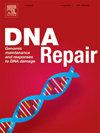SMUG1小分子激活剂促进DNA嘧啶损伤的修复。
IF 2.7
3区 生物学
Q2 GENETICS & HEREDITY
引用次数: 0
摘要
在基因高危人群中,一种潜在的有希望的靶向癌症预防方法是DNA修复途径的药理学上调。SMUG1是一种碱基切除修复酶,可改善水解和氧化损伤对嘧啶的不良遗传毒性和诱变作用。在这里,我们描述了SMUG1小分子激活剂的发现和初始细胞活性。经过激酶抑制剂文库的筛选和反复的结构-活性关系研究,产生了化合物40 (SU0547),该化合物在体外100 nM下激活SMUG1的活性高达350 ± 60 %,AC50为4.3 ± 1.1 µM。为了研究化合物40对内源性SMUG1的影响,我们对5-羟甲基-2'-脱氧尿嘧啶(5-hmdU)进行了体外细胞实验,5-羟甲基-2'-脱氧尿嘧啶是一种被SMUG1选择性去除的嘧啶氧化产物。在几种人类细胞系中,化合物40在3-5 µM下显著降低了5-hmdU的细胞毒性,并降低了受损核苷诱导的双链断裂水平。我们得出结论,SMUG1激活剂化合物40是研究5-hmdU毒性机制和抑制细胞DNA中嘧啶损伤的潜在有益作用的有用工具。本文章由计算机程序翻译,如有差异,请以英文原文为准。
Small-molecule activator of SMUG1 enhances repair of pyrimidine lesions in DNA
A potentially promising approach to targeted cancer prevention in genetically at-risk populations is the pharmacological upregulation of DNA repair pathways. SMUG1 is a base excision repair enzyme that ameliorates adverse genotoxic and mutagenic effects of hydrolytic and oxidative damage to pyrimidines. Here we describe the discovery and initial cellular activity of a small-molecule activator of SMUG1. Screening of a kinase inhibitor library and iterative rounds of structure-activity relationship studies produced compound 40 (SU0547), which activates SMUG1 by as much as 350 ± 60 % in vitro at 100 nM, with an AC50 of 4.3 ± 1.1 µM. To investigate the effect of compound 40 on endogenous SMUG1, we performed in vitro cell-based experiments with 5-hydroxymethyl-2’-deoxyuridine (5-hmdU), a pyrimidine oxidation product that is selectively removed by SMUG1. In several human cell lines, compound 40 at 3–5 µM significantly reduces the cytotoxicity of 5-hmdU and decreases levels of double-strand breaks induced by the damaged nucleoside. We conclude that the SMUG1 activator compound 40 is a useful tool to study the mechanisms of 5-hmdU toxicity and the potentially beneficial effects of suppressing damage to pyrimidines in cellular DNA.
求助全文
通过发布文献求助,成功后即可免费获取论文全文。
去求助
来源期刊

DNA Repair
生物-毒理学
CiteScore
7.60
自引率
5.30%
发文量
91
审稿时长
59 days
期刊介绍:
DNA Repair provides a forum for the comprehensive coverage of DNA repair and cellular responses to DNA damage. The journal publishes original observations on genetic, cellular, biochemical, structural and molecular aspects of DNA repair, mutagenesis, cell cycle regulation, apoptosis and other biological responses in cells exposed to genomic insult, as well as their relationship to human disease.
DNA Repair publishes full-length research articles, brief reports on research, and reviews. The journal welcomes articles describing databases, methods and new technologies supporting research on DNA repair and responses to DNA damage. Letters to the Editor, hot topics and classics in DNA repair, historical reflections, book reviews and meeting reports also will be considered for publication.
 求助内容:
求助内容: 应助结果提醒方式:
应助结果提醒方式:


